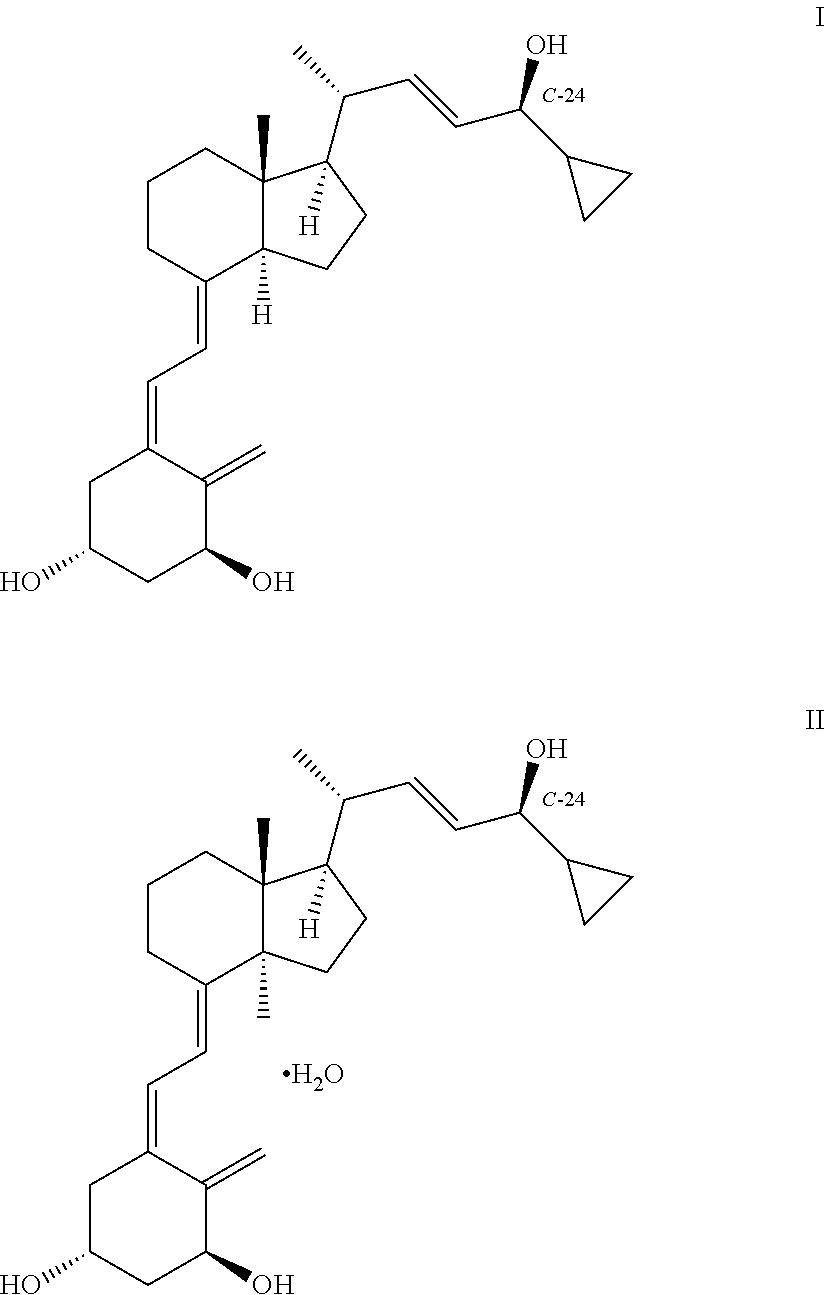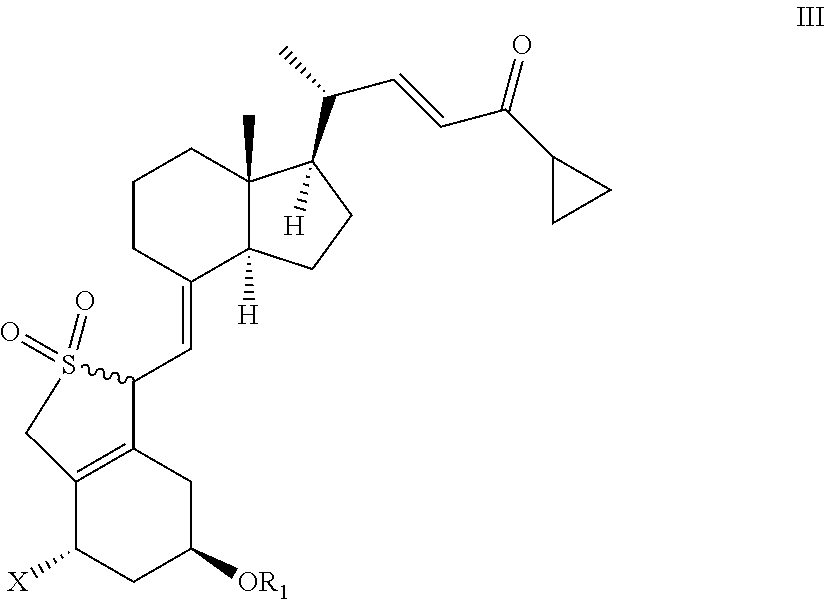Stereoselective synthesis of vitamin d analogues
a technology selective synthesis, applied in the field of stereoselective synthesis of vitamin d analogues, can solve the problems of difficult separation of desired s-epimer from such a mixture by chromatography on a production scale, unfavourable process for scaling up, and high cost of enzymes employed
- Summary
- Abstract
- Description
- Claims
- Application Information
AI Technical Summary
Benefits of technology
Problems solved by technology
Method used
Image
Examples
embodiments
[0093]In a currently most preferred embodiment of the present invention X represents OR2.
[0094]In a currently preferred embodiment of the present invention R1 and / or R2 represent alkylsilyl, such as tert-butyldimethylsilyl, most preferably R1 and R2 are the same.
[0095]In another embodiment of the present invention R1 and R2 represent hydrogen.
[0096]In a currently preferred embodiment of the present invention the reducing agent is a borane reducing agent, such as N,N-diethylaniline-borane, borane-tetrahydrofuran, or borane dimethylsulfide.
[0097]In a currently preferred embodiment of the invention, the reducing step is carried out with a chiral reducing agent or in the presence of a chiral auxiliary.
[0098]In a currently preferred embodiment of the present invention the chiral auxiliary is a chiral 1,2-amino-alcohol, such as a chiral cis-1-amino-2-indanol derivative, such as (1S,2R)-(−)-cis-1-amino-2-indanol.
[0099]In a currently preferred embodiment of the present invention the reducin...
example 1
III: X═OR2, R1, R2=tert-butyldimethylsilyl
1(S),3(R)-bis(tert-butyldimethylsilyloxy)-20(R)-(3′-cyclopropyl-3′-oxoprop-1′(E)-enyl)-9,10-secopregna-5(E),7(E),10(19)-triene SO2-adducts
[0150]20(R),1(S),3(R)-bis(tert-butyldimethylsilyloxy)-20-(3′-cyclopropyl-3′-oxoprop-1′(E)-enyl)-9,10-secopregna-5(E),7(E),10(19)-triene (prepared according to the method described by M. J. Calverley, Tetrahedron, Vol. 43, No. 20, pp. 4609-4619, 1987) (20.0 g) was dissolved in toluene (210 ml) at 20° C. followed by the addition of water (40 ml) and SO2 (20 ml) with stirring. When the reaction was judged to be complete by HPLC {Column LiChrosorb Si 60 5 μm 250×4 mm from Merck, 2 ml / min flow, detection at 270 nm & mass detection, hexane / ethyl acetate 9:1 (v:v)}, usually after 2-2.5 hours, a mixture of sodium hydroxide (27.7%, 60 ml) and water (80 ml) was added at 10-18° C. until pH 6 of the reaction mixture. The toluene phase was separated and the solvent removed in vacuo without heating (preferably below 30°...
example 2
III: X═OR2, R1, R2=hydrogen
1(S),3(R)-dihydroxy-20(R)-(3′-cyclopropyl-3′-oxoprop-1′(E)-enyl)-9,10-secopregna-5(E),7(E),10(19)-triene SO2-adducts
[0153]Same method as in Example 1, except that the starting material was 1(S),3(R)-dihydroxy-20(R)-(3′-cyclopropyl-3′-oxoprop-1′(E)-enyl)-9,10-secopregna-5(E),7(E),10(19)-triene from preparation 1. 1H NMR (CDCl3) III / X═OR2, R1, R2=hydrogen δ=6.80 (dd,1H), 6.15 (d,1H), 4.75 (m,2H), 4.5-3.9 (m,4H), 3.70 (d,1H), 2.60 (m,1H), 2.5-0.8 (m,25H), 0.68 (s,3H) ppm; 13C NMR (CDCl3) III / X═OR2, R1, R2=hydrogen δ=201.0, 152.1, 151.0, 133.7, 129.2, 128.3, 108.8, 67.3, 65.1, 63.6, 56.1, 55.9, 55.5, 46.5, 40.1, 39.9, 33.9, 29.8, 27.4, 23.9, 22.1, 19.5, 18.9, 12.2, 11.2 ppm.
[0154]Preparation 2:
VII: X═OR2, R1=hydrogen, R2=tert-butyldimethylsilyl
1(S)-tert-butyldimethylsilyl-3(R)-hydroxy-20(R)-(3′-cyclopropyl-3′-oxoprop-1′(E)-enyl)-9,10-secopregna-5(E),7(E),10(19)-triene
[0155]20(R),1(S),3(R)-bis(tert-butyldimethylsilyloxy)-20-(3′-cyclopropyl-3′-oxoprop-1′(E)-enyl...
PUM
| Property | Measurement | Unit |
|---|---|---|
| temperature | aaaaa | aaaaa |
| temperature | aaaaa | aaaaa |
| temperature | aaaaa | aaaaa |
Abstract
Description
Claims
Application Information
 Login to View More
Login to View More - R&D
- Intellectual Property
- Life Sciences
- Materials
- Tech Scout
- Unparalleled Data Quality
- Higher Quality Content
- 60% Fewer Hallucinations
Browse by: Latest US Patents, China's latest patents, Technical Efficacy Thesaurus, Application Domain, Technology Topic, Popular Technical Reports.
© 2025 PatSnap. All rights reserved.Legal|Privacy policy|Modern Slavery Act Transparency Statement|Sitemap|About US| Contact US: help@patsnap.com



